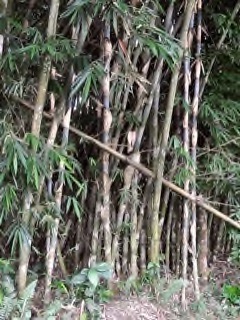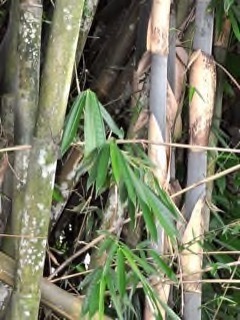 |
|
wikimedia.org Wibowo Djatmiko (Wie146) |
 |
| wikimedia.org Wibowo Djatmiko (Wie146) |
Translate this page:
Summary
Physical Characteristics

 Gigantochloa apus is an evergreen Bamboo growing to 20 m (65ft) by 6 m (19ft) at a fast rate.
Gigantochloa apus is an evergreen Bamboo growing to 20 m (65ft) by 6 m (19ft) at a fast rate.
See above for USDA hardiness. It is hardy to UK zone 10. The flowers are pollinated by Wind.
Suitable for: light (sandy), medium (loamy) and heavy (clay) soils and prefers well-drained soil. Suitable pH: mildly acid, neutral and basic (mildly alkaline) soils. It can grow in semi-shade (light woodland) or no shade. It prefers moist soil.
UK Hardiness Map
US Hardiness Map
Synonyms
Bambusa apus Schult. & Schult.f. Gigantochloa kurzii Gamble
Plant Habitats
Edible Uses
Edible Parts: Shoots
Edible Uses:
Young shoots - cooked[303 ]. Very bitter[303 ]. In Java the freshly cut shoots are buried in mud for 3 - 4 days to remove the bitter taste, before they are consumed as a vegetable[303 , 992 ].
References More on Edible Uses
Medicinal Uses
Plants For A Future can not take any responsibility for any adverse effects from the use of plants. Always seek advice from a professional before using a plant medicinally.
None known
References More on Medicinal Uses
The Bookshop: Edible Plant Books
Our Latest books on Perennial Plants For Food Forests and Permaculture Gardens in paperback or digital formats.

Edible Tropical Plants
Food Forest Plants for Hotter Conditions: 250+ Plants For Tropical Food Forests & Permaculture Gardens.
More

Edible Temperate Plants
Plants for Your Food Forest: 500 Plants for Temperate Food Forests & Permaculture Gardens.
More

More Books
PFAF have eight books available in paperback and digital formats. Browse the shop for more information.
Shop Now
Other Uses
The culms are durable, 8 - 30 metres long, 4 - 13cm in diameter, with a thick wall up to 15mm thick and with internodes 20 - 60cm long[303 ]. They are used as building material for roofs, walls, scaffoldings and bridges[303 , 992 ]. The culms can be split into fine strips for weaving hats, baskets and other objects; when split fine and the pieces bent, the surface does not chip off[303 , 992 ]. In the absence of more suitable species, it is sometimes used to make musical instruments, although the quality of the tones produced is inferior[303 ]. It is unsuitable for making chopsticks or toothpicks mechanically, because it has overlapping fibres[303 ].
Special Uses
Carbon Farming
References More on Other Uses
Cultivation details
Industrial Crop: Biomass Management: Managed Multistem Regional Crop
Prefers growing in the tropical humid low-lands, but also occurs on hill slopes at elevations up to 1,500 metres[303 ]. Grows well in clay soils[303 ]. When growing in drier areas, the culms remain smaller[303 ]. One year after planting the vegetatively obtained propagules, about 10 - 15 culms will emerge; they are harvestable 1 - 3 years later, depending on the use[310 ]. Annual yields of 1,000 culms per hectare can be obtained[310 ]. Bamboos have an interesting method of growth. Each plant produces a number of new stems annually - these stems grow to their maximum height in their first year of growth, subsequent growth in the stem being limited to the production of new side branches and leaves. In the case of some mature tropical species the new stem could be as much as 30 metres tall, with daily increases in height of 30cm or more during their peak growth time. This makes them some of the fastest-growing species in the world[K ]. Bamboos in general are usually monocarpic, living for many years before flowering, then flowering and seeding profusely for a period of 1 - 3 years before usually dying. The plant flowers very rarely - in Indonesia, flowering may start 50 - 60 years after planting[310 ]. When flowering, viable seed is produced that can be used for propagation[310 ]. The overlapping of rhizomes in old clumps often raises the middle portion of the clump high above the ground[303 ]. The culm size can vary considerably, leading local people to use different names for plants with different culm sizes[303 ].
Carbon Farming
-
Industrial Crop: Biomass
Three broad categories: bamboos, resprouting woody plants, and giant grasses. uses include: protein, materials (paper, building materials, fibers, biochar etc.), chemicals (biobased chemicals), energy - biofuels
-
Management: Managed Multistem
Regularly removing some multiple stems. A non-A non-destructive management systems maintaining the soil organic carbon.
-
Regional Crop
These crops have been domesticated and cultivated regionally but have not been adopted elsewhere and are typically not traded globally, Examples in this broad category include perennial cottons and many nuts and staple fruits.
References Carbon Farming Information and Carbon Sequestration Information
Temperature Converter
Type a value in the Celsius field to convert the value to Fahrenheit:
Fahrenheit:
The PFAF Bookshop
Plants For A Future have a number of books available in paperback and digital form. Book titles include Edible Plants, Edible Perennials, Edible Trees,Edible Shrubs, Woodland Gardening, and Temperate Food Forest Plants. Our new book is Food Forest Plants For Hotter Conditions (Tropical and Sub-Tropical).
Shop Now
Plant Propagation
Seed - Rhizome cuttings consist of fragments of young rhizomes bearing 1 - 2 culm buds[303 ]. They are raised in a nursery and, when well rooted, are transplanted to the field at a spacing of 5 - 7 m2[303 ]. Culm cuttings consist of culm segments or whole culms. Good results were obtained with one-year-old culm segments bearing 2 buds each[303 ]. The cuttings are set upright or at an angle, with the node well covered with soil[303 ]. It is not advisable to propagate vegetatively from flowering clumps, as the new plants will also start flowering soon after planting[303 ].
Other Names
If available other names are mentioned here
Bambu apus, Bambu tali, Clumping bamboo, Goba-wa, Mai lai, Wa-do
Native Plant Search
Search over 900 plants ideal for food forests and permaculture gardens. Filter to search native plants to your area. The plants selected are the plants in our book 'Plants For Your Food Forest: 500 Plants for Temperate Food Forests and Permaculture Gardens, as well as plants chosen for our forthcoming related books for Tropical/Hot Wet Climates and Mediterranean/Hot Dry Climates. Native Plant Search
Found In
Countries where the plant has been found are listed here if the information is available
Asia, Australia, China, India, Indochina, Indonesia, Laos, Malaysia, Myanmar, Northeastern India, SE Asia, Singapore, Thailand
Weed Potential
Right plant wrong place. We are currently updating this section.
Please note that a plant may be invasive in one area but may not in your area so it’s worth checking.
None Known
Conservation Status
IUCN Red List of Threatened Plants Status : This taxon has not yet been assessed

Growth: S = slow M = medium F = fast. Soil: L = light (sandy) M = medium H = heavy (clay). pH: A = acid N = neutral B = basic (alkaline). Shade: F = full shade S = semi-shade N = no shade. Moisture: D = dry M = Moist We = wet Wa = water.

Expert comment
Author
(Schult. & Schult.f.) Kurz ex Munro
Botanical References
Links / References
For a list of references used on this page please go here
A special thanks to Ken Fern for some of the information used on this page.
Readers comment
| Add a comment |
|
If you have important information about this plant that may help other users please add a comment or link below. Only comments or links that are felt to be directly relevant to a plant will be included. If you think a comment/link or information contained on this page is inaccurate or misleading we would welcome your feedback at [email protected]. If you have questions about a plant please use the Forum on this website as we do not have the resources to answer questions ourselves.
* Please note: the comments by website users are not necessarily those held by PFAF and may give misleading or inaccurate information.
To leave a comment please Register or login here All comments need to be approved so will not appear immediately.
|
Subject : Gigantochloa apus
|
|
|
|